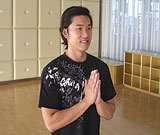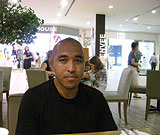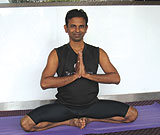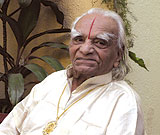|
Yoga is catching up in Malaysia big time. Practitioners these days cut across age-groups. The working classes are joining in, initially to de-stress their over-occupied minds, and then to gradually look beyond everyday living and to enter a phase of introspection and self healing.
It was in July when a local organization organized a 2-day Malaysian Yoga Festival at a high-end resort, that the power of this ageless practice became clear. The assortment at the Festival included such trendy concepts like Power Yoga, Vinyasa Yoga, Yoga Pilates, Hatha Yoga, Restorative Yoga, Inspired Acro Yoga, Yin Yang Yoga and Gentle Flow Yoga. Like the last named category, it does seem that Yoga is flowing gently from the west, and entering the hearts of the east, especially the hitherto untouched regions in south Asia. The camp also threw light on the recently-acquired penchant of the people of Malaysia towards this art of healing.
“Malaysians take up yoga for different reasons. Take for instance, some club members at True Fitness find that attending yoga sessions regularly help their back, shoulder or respiratory problem while other members who appreciate this form of exercise, took to it to stay healthy and look good in general,” says G. Radhakrishnan, a Yoga teacher at the True Fitness Club decorated with the honorific of World Yoga champion in Argentina and Portugal in 2001 and 2003.
More and more young members from the working classes in Malaysia are choosing the option of quick and rapid result-oriented techniques of Yoga. “In my class the young take up Astanga Yoga”, says Nicholas Cheah who, interestingly, earned a certificate in Yoga practice from an institution in Australia. Nicholas is a certified fitness trainer and also a sailor. He got attracted towards Yoga, like Radhakrishnan, while still in his teens. “I did various courses in physical fitness including physiotherapy but I always use to think that there is something missing. The moment I learned Yoga, I saw that space getting filled up with joy and peace and I felt a sense of belongingness.”

Nicholas Cheah
|

Jason Issac
|

Radhakrishnan
|

BKS Iyengar |
YOGI IYENGAR AND HIS LEGACY
In the immortal words of Yogi B.K.S. Iyengar, “the moment the intellect of the heart and mind meets through complete understanding of body and mind cleansing, that is when the consciousness of the egoistic self or the “I” is nullified and a practitioner experiences boundless uncolored joy.”
Once ranked among the top 100 most influential people in the world, Yogi Iyengar made yoga accessible to the common man. No matter what stage of life one is in, he can choose any ashram of vedic system irrespective of age, caste and creed. Iyengar teaches yoga that encourages students to go in for inner contemplation and adheres to meditation methods for realizing absolute peace. Most of his students comprise westerners. For centuries in the west, Yoga was erroneously perceived as an acrobatic art, less as a means to go deeper into the self. Indian spirituality and its Vedic wisdom attracted many westerners. They came to learn that it is not merely an act of moving body parts and they learned Patanjali’s “yog” as a healing science and a medium to connect mind and body, as a means to move towards the Highest Consciousness.
Patanjali’s system comprises of 108 body postures with 8 sutras to attain “Samadhi” and today it has many branches across the globe. “There are two types of yoga according to me. One is classical or simple yoga and the other is commercial. Simple one is the original version of Patanjali sutras and is a penance that people undertake. Another one is commercial that acts like Mr. Fix It on body. One sweats it out to bring body in shape in short frame of time”, says Jason Isaac, representative of Malaysia on World Yoga Counsel and also secretary of Malaysian Yoga Society.
Isaac has been an aerobics instructor and over a period of time he developed severe problems in the spine. Doctors gave up all hopes of its ailment and he was forced to stop aerobics. At this juncture he came in touch with his Yoga teacher Mani Sekaran. For 7 years he learned yoga under his guidance and today he teaches yoga and is at peace with himself. “Commercial yoga is fact paced and is all about burning calories and it is very popular among the young generations. On the other hand, classical or simple Yoga is slow, steady and gives holistic results including fat burn over a period of time. The elderly, especially among the Chinese, are more inclined towards it,” says Isaac.
Patanjali’s Yoga was first put into practice during the glorious Mauryan period in Indian history, about 2,200 to 2,300 years ago. Since, it has taken myriad forms and many paths. One thing is for certain, though. Whether in Malaysia, India or any other part of the world, the ultimate aim, as Patanjali so lucidly told us centuries ago, is the attainment of
Samadhi.
|